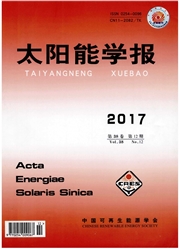
欢迎您!东篱公司
退出

 中文摘要:
中文摘要:
针对不同空气流向对电堆性能的影响进行ANSYS/Fluent仿真分析,开展实验研究,在环境温度、风扇转速等外界条件不变的情况下,测量两种不同工作温度下外部风扇“吸风”与“吹风”两种空气流动方式对电堆总输出和各单电池输出特性的影响。结果表明:采用“吸风”方式供应空气(即正向流动)时,电堆的均匀性和稳定性等性能明显较好。考虑到电堆使用寿命,空冷质子交换膜电堆采用空气正向流动方式更为有利。
 英文摘要:
英文摘要:
ANSYS/Fluent was used to simu|ate and ana|yze the effect of different air flow direction on performance of the stack. The output performance of the stack and each cell under different air flow directions were measured in both low and high operation temperatures with external conditions such as the ambient temperature and the fan speed unchanged. The results showed that the uniformity, stability and service life of the stack under positive air flow are much better than the reverse flow.
 同期刊论文项目
同期刊论文项目
 同项目期刊论文
同项目期刊论文
 Active control strategy based on vector-proportion integration controller for proton exchange membra
Active control strategy based on vector-proportion integration controller for proton exchange membra Development of Energy Management System based on a Power Sharing Strategy for a Fuel Cell-Battery-Su
Development of Energy Management System based on a Power Sharing Strategy for a Fuel Cell-Battery-Su Design of Proton Exchange Membrane Fuel Cell Grid-connected System based on Resonant Current Control
Design of Proton Exchange Membrane Fuel Cell Grid-connected System based on Resonant Current Control Study on Air-cooled Self-humidifying PEMFC Control Method Based on Segmented Predict Negative Feedba
Study on Air-cooled Self-humidifying PEMFC Control Method Based on Segmented Predict Negative Feedba Experimental Study on Anode and Cathode Pressure Difference Control and Effects in a Proton Exchange
Experimental Study on Anode and Cathode Pressure Difference Control and Effects in a Proton Exchange The development and performance analysis of all-China-made PEM fuel cell unit and 1 kW level fuel ce
The development and performance analysis of all-China-made PEM fuel cell unit and 1 kW level fuel ce Preparation of highly active and stable polyaniline-cobalt-carbon nanotube electrocatalyst for oxyge
Preparation of highly active and stable polyaniline-cobalt-carbon nanotube electrocatalyst for oxyge 期刊信息
期刊信息
